tin free steel sheet
- Loading Port:
- China Main Port
- Payment Terms:
- TT OR LC
- Min Order Qty:
- -
- Supply Capability:
- -
OKorder Service Pledge
Quality Product, Order Online Tracking, Timely Delivery
OKorder Financial Service
Credit Rating, Credit Services, Credit Purchasing
You Might Also Like
Packaging&Delivery
Packaging Detail:Rust-proof paper+thin plastic film+cardboard+galvanized iron+mental band+wooden pallet.Laded into 20 feet container with max weight 25 tons.
Delivery Detail:30-60 days after the receipt of buyers' deposit.
Specifications
tin free steel describe:
1.Thickness:0.15-0.36mm
2.Tamper:T2-DR8/BA
3.Finish:Bright/Matte/Stone
4.Coating weight:80-120mg/㎡
- Q:What are the main applications of tinplate in the marine industry?
- Tinplate is commonly used in the marine industry for applications such as corrosion-resistant coatings for steel structures, manufacturing of storage tanks and containers, shipbuilding and repair, and as a protective barrier in marine electrical systems.
- Q:What are the different types of tinplate printing techniques?
- There are three main types of tinplate printing techniques: lithography, silk screen printing, and varnishing.
- Q:What are the regulations regarding the use of tinplate in food packaging?
- The regulations regarding the use of tinplate in food packaging vary depending on the country and region. However, in general, tinplate used in food packaging must meet certain safety standards to ensure that it does not contaminate or pose any health risks to consumers. These standards often involve regulations on the composition of the tinplate, such as restrictions on hazardous substances like heavy metals, as well as requirements for coatings or linings to prevent direct contact between the food and the metal. Additionally, labeling requirements may exist to inform consumers about the presence of tinplate in the packaging. It is important for manufacturers and suppliers to comply with these regulations to ensure the safety and quality of food packaging.
- Q:Can tinplate be used for packaging products with sharp edges?
- Yes, tinplate can be used for packaging products with sharp edges as it provides a sturdy and protective barrier that helps prevent damage during transportation and handling.
- Q:What are the different thickness options for tinplate?
- The different thickness options for tinplate typically range from 0.13mm to 0.5mm.
- Q:What are the common surface treatments for tinplate?
- The common surface treatments for tinplate include electrolytic tin plating, chrome plating, and lacquering.
- Q:What are the different methods of printing on tinplate?
- There are various methods used for printing on tinplate, including lithography, screen printing, and digital printing. Lithography involves transferring an image onto a metal plate, which is then inked and pressed onto the tinplate. Screen printing utilizes a mesh stencil to transfer ink onto the tinplate. Digital printing, on the other hand, involves directly printing the desired image onto the tinplate using specialized printers. These methods offer versatility and allow for the creation of high-quality designs on tinplate for various applications.
- Q:What are the common misconceptions about tinplate packaging?
- One common misconception about tinplate packaging is that it is easily dented or damaged. In reality, tinplate is quite durable and can withstand rough handling without losing its structural integrity. Another misconception is that tinplate packaging is not environmentally friendly. However, tinplate is highly recyclable and can be reused multiple times, making it a sustainable packaging option.
- Q:How does tinplate affect the cost of packaging?
- Tinplate affects the cost of packaging by adding to the overall production expenses due to its higher cost compared to other materials, such as aluminum or plastic. However, tinplate offers several advantages like superior durability and barrier properties, which can contribute to reducing product waste and increasing shelf life. Therefore, while tinplate may increase the packaging cost, it can also provide added value and cost savings in terms of product protection and extended shelf life.
- Q:What are the main uses of tinplate?
- Tinplate is primarily used for packaging and canning purposes due to its excellent corrosion resistance and ability to maintain the quality and freshness of food products. It is also utilized in the production of metal containers, aerosol cans, bottle caps, and various household items. Additionally, tinplate finds applications in the manufacturing of electrical components, such as transformers and capacitors, as well as in the construction industry for roofing and cladding purposes.
1. Manufacturer Overview |
|
|---|---|
| Location | |
| Year Established | |
| Annual Output Value | |
| Main Markets | |
| Company Certifications | |
2. Manufacturer Certificates |
|
|---|---|
| a) Certification Name | |
| Range | |
| Reference | |
| Validity Period | |
3. Manufacturer Capability |
|
|---|---|
| a)Trade Capacity | |
| Nearest Port | |
| Export Percentage | |
| No.of Employees in Trade Department | |
| Language Spoken: | |
| b)Factory Information | |
| Factory Size: | |
| No. of Production Lines | |
| Contract Manufacturing | |
| Product Price Range | |
Send your message to us
tin free steel sheet
- Loading Port:
- China Main Port
- Payment Terms:
- TT OR LC
- Min Order Qty:
- -
- Supply Capability:
- -
OKorder Service Pledge
Quality Product, Order Online Tracking, Timely Delivery
OKorder Financial Service
Credit Rating, Credit Services, Credit Purchasing
Similar products
New products
Hot products
Related keywords




























